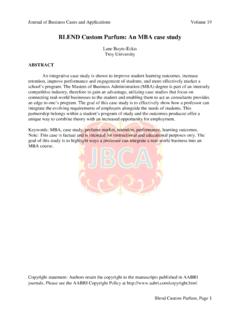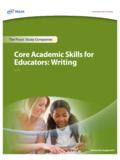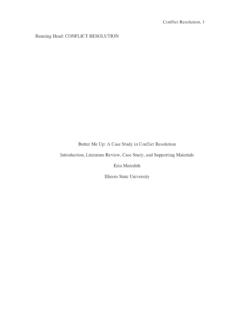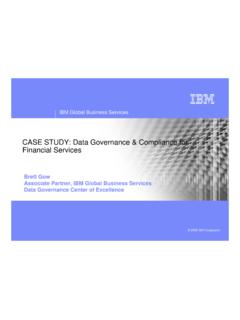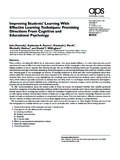Transcription of RIMS-CRMP Examination Study Guide
1 rims -CRMPE xamination Study GuideCertification Programs5 Bryant Park, 13th Floor, New York, NY 10018(212) 286-9292 | 2017 Risk and Insurance Management Society, Inc. All rights reserved. Confidential. Do not disclose without written permission from rims General Counsel. 1 RIMS-CRMP Examination Study GuideTable of ContentsIntroduction .. 2 Section 1 Background and Process .. 3 About the RIMS-CRMP designation .. 3 Study review process .. 3 Approaches to memory and retention .. 4 Strategies for analysis of an exam question .. 4 General strategies for taking the exam .. 5 Test Preparation Strategies .. 6 What to expect at the testing center .. 6 Section 2 Exam Outline and Review Components .. 8 Summary of core competencies .. 8 Review Components .. 9 Section 3 Review .. 10 Analyzing the Business Model .. 10 Designing Organizational Risk Strategies .. 13 Implementing Risk Process .. 16 Developing Organizational Risk Competency .. 19 Supporting Decision Making.
2 21 Appendix A .. 23 Glossary .. 25 References .. 26 Tables and FiguresFigure 1 Generic Labeled Example of a 4-Choice Multiple-Choice Item .. 4 Figure 2 Graphical Representation of Domains within the Certification Curriculum .. 8 Table 1 Domains and Key Duties ..9 Table 2 Sample Self-Assessment Checklist .. 11 Table 3 Self-Assessment for the Domain Area of Analyzing the Business Model .. 12 Table 4 Self-Assessment for the Domain Area of Designing Organizational Risk Strategies .. 15 Table 5 Self-Assessment for the Domain Area of Implementing Risk Process .. 18 Table 6 Self-Assessment for the Domain Area of Developing Organizational Risk Competency .. 20 Figure 3 Risk Management Decision Making Environments .. 21 Table 7 Self-Assessment for the Domain Area of Supporting Decision Making .. 22 2017 Risk and Insurance Management Society, Inc. All rights reserved. Confidential. Do not disclose without written permission from rims General Counsel.
3 2 RIMS-CRMP Examination Study GuideIntroductionThank you for your interest in the rims Certified Risk Management Professional ( RIMS-CRMP ) Examination administered by rims , the risk management who qualify for the RIMS-CRMP Examination have already met the eligibility requirements identified in the Candidate Handbook, and on the RIMS-CRMP website. The Candidate Handbook provides detail on eligibility requirements, Examination logistics, and recertification requirements, the Code of Ethics and additional policies. The Candidate Handbook is available on the rims website at: The purpose of this document is to serve as a Study Guide for candidates taking the RIMS-CRMP certification Examination . It is not intended to replace any textbook or other resources you need to prepare for the Examination , and using this Guide does not guarantee that you will pass the Examination . The Study Guide is divided into two sections. The first section deals with the background of the CRMP designation and provides guidance on the process of studying, taking examinations, and managing expectations around testing centers.
4 The second section summarizes five core competencies of a risk professional:1. Analyzing the Business Model2. Designing Organizational Risk Strategies3. Implementing Risk Process4. Developing Organizational Risk Competency, and5. Supporting Decision then reviews each of the core competencies based on six review components:1. Content area specifics2. Learning objectives3. Examples4. Recommended reading5. Self-assessment of content areas, and6. Sample exam questionsThe Study Guide concludes with a consolidated glossary of terms and bibliography. 2017 Risk and Insurance Management Society, Inc. All rights reserved. Confidential. Do not disclose without written permission from rims General Counsel. 3 RIMS-CRMP Examination Study GuideSection 1 - Background and Process About the RIMS-CRMP CertificationAs the preeminent organization dedicated to advancing the practice of risk management, rims is a global not-for-profit organization representing more than 3,500 industrial, service, nonprofit, charitable and government entities throughout the world.
5 Founded in 1950, rims brings networking, professional development and education opportunities to its membership of more than 11,000 risk management professionals who are located in more than 60 RIMS-CRMP certification defines the highest achievement of risk management competencies for the risk management professional. Individuals who earn the RIMS-CRMP have demonstrated their knowledge and competency in the area of risk management, and are dedicated to upholding high standards of ethical and professional conduct. It represents the standard of education, experience and integrity that the discipline requires. Individuals who earn and retain the RIMS-CRMP certification are required to: meet the application requirements, provide supporting documentation, pass a rigorous exam, uphold an established Code of Ethics and meet certification maintenance require-ments. Typically rims -CRMPs have expertise in risk management and have chosen to supplement their existing professional knowledge by earning the RIMS-CRMP may use the credential to establish credibility within their organization and among risk management professionals.
6 Adding the RIMS-CRMP certification to your professional profile verifies that you have achieved the highest level of expertise, education and experience required to successfully manage risk and create value for your Review ProcessPeople review and process information in different ways. Some individuals find memorization easily, while others sort facts into a contextual framework. The RIMS-CRMP Examination requires that you know factual data and use the information in decision-making and/or apply the information to a situation. Some individuals prefer to Study alone, while others prefer a Study partner or Study group. Discussing information with a partner or in a group can help clarify, process and integrate information. You are the best judge of your Study preferences, so stick with what has worked best in the past. Some individuals learn better by hearing information, while others learn better by reading or writing information. How do you tackle new objectives?
7 If you hear about something exciting and want to learn more, how do you go about finding information? Do you read about it, take a class, call an expert and ask for a demonstration, purchase equipment and teach yourself? If you chose one of these options, then that is most likely the way you prefer to learn. Some choose a combination of methods and that is fine too. However, one choice may stand out more than the others. For example, if you chose to ask an expert, then you may prefer a hands-on approach where you can encounter trial and error and get input and feedback from someone knowledgeable in that your preference and find activities to support that learning preference. For example, you can attend courses, view webinars that can be repeated, highlight texts or write flash cards that can be groups are a great way to be accountable for studying for an exam. The leader may utilize this Study Guide and/or additional resources as tools.
8 It is helpful when candidates can talk through ideas and support each other in their learning endeavors. Finally, plan a Study strategy and schedule in advance to allow sufficient time to prepare. 2017 Risk and Insurance Management Society, Inc. All rights reserved. Confidential. Do not disclose without written permission from rims General Counsel. 4 RIMS-CRMP Examination Study GuideApproaches to Memory and RetentionThis section outlines some tips for memorization and retention. While the RIMS-CRMP Examination is not based on rote-learning and memorization, these techniques can prove effective to remember and recall pertinent concepts and facts to not only help on the exam but in other learning ventures as and recall is a key component of studying. While you may already possess the practical knowledge, recalling it during a time of stress may prove challenging. One key strategy to recalling information is to self-test. As you compile and address areas of content areas from the exam, a theory called the testing effect shows that learning is enhanced by the act of recalling information after exposure (Dobson, and Linderholm, 2015).
9 This simply means that by reading information, recalling and reviewing as much as possible (self-test) and then re-reading the information, retention was found to be greater than just reading and taking techniques associated with recalling information are:1. Get organized. Find a quiet, uncluttered space in which to Study . Organize notes according to domain and content area. If you are studying in a group, make sure the group space is free from distractions from outside noise, chatter and clutter. 2. Make it meaningful. Create mnemonic devices to help recall formal names of concepts. Various types of devices include rhyming (I before E except after ), names (Roy G Biv = colors of the rainbow), or notecards. It s also best, when possible to relate a concept to a personal experience. If personal experience is attached, the concept holds more meaning therefore it may be recalled more Don t cram. Spread studying out over several days or weeks.
10 Study in chunks of time. Do not spend three, four, or five consecutive hours studying. Take frequent breaks (every 20-25 minutes) to refresh and have some recuperation Take notes and create flashcards. Everyone has a laptop at their disposal. Research shows that taking notes by hand is better than taking notes on a laptop for remembering conceptual information over the long term (Mueller, P,A. and Oppenheimer, 2014).The old-fashioned method of taking notes by hand forces you to synthesize information in ways that typing doesn t. 5. Get enough sleep. The right amount of sleep aids in better performance, mental agility and wards off stress. While sleeping the brain converts facts from short-term memory into long-term for analysis of an exam questionAll questions on the RIMS-CRMP Examination are in the four-choice multiple-choice item type format. This item format consists of a stem, which is in the form of a question or incomplete statement, and four response options.

